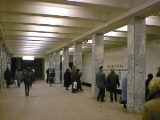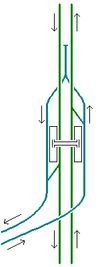
Kashirskaya
Encyclopedia

Moscow Metro
The Moscow Metro is a rapid transit system serving Moscow and the neighbouring town of Krasnogorsk. Opened in 1935 with one line and 13 stations, it was the first underground railway system in the Soviet Union. As of 2011, the Moscow Metro has 182 stations and its route length is . The system is...
. It was opened on 11 August 1969 as part of the Kakhovsky radius extension, and from 1983 was an interchange between the Kakhovskaya and the Orekhovskaya branches of the Zamoskvoretskaya Line
Zamoskvoretskaya Line
Zamoskvoretskaya Line , formerly Gorkovsko-Zamoskvoretskaya , is a line of the Moscow Metro. Opened in 1938, chronologically it became the third line. There are twenty stations on the Zamoskvoretskaya line, and it spans , roughly crossing Moscow in a north-south direction. A normal trip along the...
. Since 1995 it is officially classed as two stations after the Kakhovskaya Line
Kakhovskaya Line
Kakhovskaya Line is a line of the Moscow Metro. Although the line was formed in 1995, all of the stations date to 1969 when they opened as part of the Zamoskvoretskaya Line. The Kakhovskaya Line is the only conventional line that lacks a full transfer to the ring...
's separation, and also becoming the terminus of it.
Layout and design
The station consists of two parallel halls of identical pillar-trispan (centipede) design typical of the 1960s stations. Decoratively the halls differ from each other no more than from any other centipede stations built at the time. The eastern hall work of architects Nikolay Demchinsky and Yuliya Kolesnikova, features a grey marble coat on the rectangular pillars, white ceramic tiles on the walls (with a black socle on the tracks) and red granite floor with an asphalt on the platform edge.The western hall is identical except the pillars are faced with brown marble, the floor is laid with grey granite instead of red and the ceramic wall has a slightly indigo shade instead of pale white. (work of architects Nina Alyoshina and Nataliya Samoylova). The station's design focus comes from its name which is ultimately derived from the Kashira Hydroelectric Station located in Kashira
Kashira
Kashira is a town and the administrative center of Kashirsky District of Moscow Oblast, Russia, located on the Oka River south of Moscow. Population:...
and for the Moscow Engineering Physics Institute
Moscow Engineering Physics Institute
National Research Nuclear University MEPhI / NRNU MEPhI, NIYaU MEPhI or MEPhI) is one of the most recognized technical universities in Russia. MEPhI was founded in 1942 as the Moscow Mechanical Institute of Munitions , but it was soon renamed the Moscow Mechanical Institute. Its original mission...
located nearby. Both halls feature large metallic artworks by Z.Vetrova based on the theme of electrification.
Location
The station is located on a major transport artery in the south of Moscow, the intersection of the Andropova Avenue and the Kashirskoye HighwayKashirskoye Highway
Kashirskoye Highway or Kashira Highway is a major street in Moscow, Russia, continued as a highway beyond the city into Moscow Oblast as a backup route for highway M4. It was named in the 19th century after the old Kashira Road, which led to the town of Kashira. It was one of the sites of the...
, both roads later become the M4 and M6 (European routes E115 and E119) respectfully and continue to the Russian south. The station is also situated on a point where two Moscow's districts meet up: Nagatino-Sadovniki and Moskvorechye-Saburovo.
As a result from its opening it was prone to a large passenger traffic, particularly prior to the opening of the Orekhovo branch. To deal with this the station's entrance designs were altered from the usual underground vestibules to two surface ones (architect M.Fainshteina) which also double as a transfer point between the halls. For a more direct transfer there is also a central passage with a staircase out of the middle of the platform directly linking the two halls.
One of the main reasons why the Kakhovskaya Line was split off from the Zamoskovoretskaya was the track layout. In 1969 both platforms were opened with one track used on each one. In 1983 the extension to Orekhovo only continued the unused tracks without making provisions for a comfortable branch service. The result was (see diagram right) that only the northbound platform offered cross-platform service (which was unnecessary as the tracks would join anyway). The southbound tracks branched only after the station, and the passengers wishing to change the direction of the travel had to wait for the correct train on one side of the platform. (The ratio was 1:1 initially and 2:1 after the Orekhovo branch expanded to Krasnogvardeyskaya in 1985).
There were varying proposals to solve the problem, including building a second junction prior to the southbound platform, but this would have been impossible without any disruption to the service, an alternative scenario including switching the whole line from right to left-hand side travel, but this was also dropped out of practical reasons, one of which was that all of the Russian Metro trains had driver doors on the left only.
The solution was to separate the Kakhovskaya branch into a separate line which took place on 20 November 1995 a reversal (turnback) siding was built north of the station allowing for the Kakhovskaya Line to separate. However as the siding was built next to the Kolomenskoye Nature Reserve
Kolomenskoye
Kolomenskoye is a former royal estate situated several kilometers to the south-east of the city-centre of Moscow, Russia, on the ancient road leading to the town of Kolomna...
, environmental groups insisted it does not extend into it. This forced the siding to be slightly shorter, enough to accommodate the six car train of the Kakhovskaya Line but not long enough for the eight car train of the Zamoskvoretskaya Line.
In the distant future it is quite possible that the tracks of the Kakhovskaya line will be extended as part of the future large ring project. The actual path is disputed and the variation is either eastwards to Bratislavskaya
Bratislavskaya
Bratislavskaya is a Moscow Metro station in the Maryino District, South-Eastern Administrative Okrug, Moscow. It is on the Lyublinskaya Line, between Lyublino and Maryino stations...
and then to follow the path of the Lyublinsko-Dmitrovskaya Line to Pechatniki
Pechatniki
Pechatniki is a station of the Moscow Metro's Lyublinskaya Line. The station was opened on 28 December, 1995 as part of the first stage of the Lyublinsky radius, and is named after the district that it is situated in...
or directly to Pechatniki via a more northeast path (both featuring at least one interim station). The latter would be more practical, but Bratislavskaya has already a provision for the future transfer set in its ensemble. In any case it is too early for this to be considered seriously as the ring remains decades away from realization.

